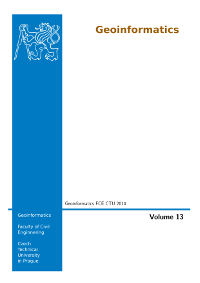Modelling the probability of building fires
DOI:
https://doi.org/10.14311/gi.13.5Keywords:
patial risk analysis, Integrated Rescue System, building fire probabilityAbstract
Systematic spatial risk analysis plays a crucial role in preventing emergencies.In the Czech Republic, risk mapping is currently based on the risk accumulationprinciple, area vulnerability, and preparedness levels of Integrated Rescue Systemcomponents. Expert estimates are used to determine risk levels for individualhazard types, while statistical modelling based on data from actual incidents andtheir possible causes is not used. Our model study, conducted in cooperation withthe Fire Rescue Service of the Czech Republic as a model within the Liberec andHradec Králové regions, presents an analytical procedure leading to the creation ofbuilding fire probability maps based on recent incidents in the studied areas andon building parameters. In order to estimate the probability of building fires, aprediction model based on logistic regression was used. Probability of fire calculatedby means of model parameters and attributes of specific buildings can subsequentlybe visualized in probability maps.References
AHOLA, T., VIRRANTAUS, K., KRISP, J.M., HUNTER, G.H. (2007). A spatio-temporal population model to support risk assessment and damage analysis for decision making. International Journal of Geographical Information Science 21(8), 935–953. doi:10.1080/13658810701349078
AGRESTI, A. (2013). Categorical Data Analysis. John Willey & Sons, New Jersey. 744 p.
ANDERSON, T. K. (2009). Kernel density estimation and K-means clustering to profile road accident hotspots. Accident Analysis & Prevention, 41(3), 359–64. doi:10.1016/j.aap.2008.12.014
CHUVIECO, E., SALAS, J. (1996). Mapping the spatial distribution of forest fire danger using GIS. International Journal of Geographical Information Systems 10 (3), (333–345). doi:10.1080/02693799608902082
CORCORAN, J., HIGGS, G., BRUNSDON, C., WARE, A., NORMAN, P. (2007). The use of spatial analytical techniques to explore patterns of fire incidence: A South Wales case study. Computers, Environment and Urban Systems, 31(6), 623–647. doi:10.1016/j.compenvurbsys.2007.01.002
COVA, T.J. (1999). GIS in emergency management. In: Longley, P., Goodchild, M., Maguire, D., Rhind, D. (eds.) Geographic Information Systems: Principles, Techniques, Management and Applications, 2nd Edition, John Wiley & Sons, New York, pp. 845–858.
DENG, O., SU, G., HUANG, Q., LI, Y. (2013). Forest Fire Risk Mapping Based on
Spatial Logistic Model of Northeastern China Forest Zone. In: Bian, F., Xie, Y., Cui,
X., Zeng, Y. (eds.) Communications in Computer and Information Science, Berlin, Heidelberg: Springer Berlin, pp. 181–192.
GODSCHALK, D. (1991). Disaster mitigation and hazard management. In: Drabek,
T.E. and Hoetmer G.J. (eds.) Emergency Management: Principles and Practice for Local Government, International City Management Association, Washington, DC, pp. 131–160.
HIGGINS, E., TAYLOR, M., JONES, M., LISBOA, P.J.G. (2013). Understanding community fire risk—A spatial model for targeting fire prevention activities. Fire Safety Journal, 62, 20–29. doi:10.1016/j.firesaf.2013.02.006
HOSMER, D.W., LEMESHOW, S. (2000). Applied Logistic Regression, 2nd Edition. John Wiley & Sons, New York. 392 p. 11. IHAMÄKI, V.P. (1997). Paikkatietojär-jestelmien (GIS) käyttö palo- ja pelastustoimen yhteistoiminnan suunnittelussa (Geographic information systems in planning cooperation between fire and rescue services), Master’s Thesis, Helsinki University, Helsinki, Finland.
KRISP, J.M., VIRRANTAUS, K, JOLMA, A. (2005). Using explorative spatial analysis methods in a GIS to improve fire and rescue services. In: P. Oosterom, S. Zlatanova, E.M. Fendel (Eds.), Geo-information for Disaster Management, Springer, Berlin, pp. 1282–1296. doi:10.1007/3-540-27468-5_89
KRÖMER, A., MUSIAL, P., FOLWARCZNY, L. (2010). Mapování rizik. Sdružení
požárního a bezpečnostního inženýrství, Ostrava.
LEVINE, N., KIM, K.E., NITZ, L.H. (1995). Spatial analysis of Honolulu motor ve-
hicle crashes: I. Spatial patterns. Accident Analysis & Prevention, 27(5), 663–674.
doi:10.1016/0001-4575(95)00017-T
LONKA, H. (1999). Risk Assessment Procedures Used in the Field of Civil Protection and Rescue Services in Different European Union Countries and Norway. Helsinki, SYKE.
SHI, W., FISHER, P.F., GOODCHILD, M.F. (2002). Spatial Data Quality. Taylor and Francis, New York. doi:10.4324/9780203303245
SULIMAN, M.D.H., MAHMUD, M., REBA, M.N.M., S,L.W. (2014). Mapping and analysis of forest and land fire potential using geospatial technology and mathematical modeling. IOP Conference Series: Earth and Environmental Science, 18 (1).
ŠPATENKOVÁ, O., STEIN, A. (2010). Identifying factors of influence in the spatial distribution of domestic fires. International Journal of Geographical Information Science, 24(6), 841–858. doi:10.1080/13658810903143634
ŠPATENKOVÁ, O., VIRRANTAUS, K. (2013). Discovering spatio-temporal relationships in the distribution of building fires. Fire Safety Journal, 62, 49–63. doi:10.1016/j.firesaf.2013.07.001
TILLANDER, K. (2004). Utilisation of statistics to assess fire risks in buildings. Doctoral Thesis, Helsinki University of Technology, Helsinki, Finland.
VANDENBULCKE, G., THOMAS, I., INT PANIS, L. (2014). Predicting cycling accident risk in Brussels: A spatial case-control approach. Accident Analysis & Prevention, 62, 341–57. doi:10.1016/j.aap.2013.07.001
WUSCHKE, K., CLARE, J., GARIS, L. (2013). Temporal and geographic clustering of residential structure fires: A theoretical platform for targeted fire prevention. Fire Safety Journal, 62, 3–12. doi:10.1016/j.firesaf.2013.07.003
XIN, J., HUANG, C. (2013). Fire risk analysis of residential buildings based on scenario clusters and its application in fire risk management. Fire Safety Journal, 62, 72–78. doi:10.1016/j.firesaf.2013.09.022
Downloads
Published
Issue
Section
License
- Authors retain copyright and grant the journal right of first publication with the work simultaneously licensed under a Creative Commons Attribution License that allows others to share the work with an acknowledgement of the work's authorship and initial publication in this journal.
- Authors are able to enter into separate, additional contractual arrangements for the non-exclusive distribution of the journal's published version of the work (e.g., post it to an institutional repository or publish it in a book), with an acknowledgement of its initial publication in this journal.
- Authors are permitted and encouraged to post their work online (e.g., in institutional repositories or on their website) prior to and during the submission process, as it can lead to productive exchanges, as well as earlier and greater citation of published work (See The Effect of Open Access).

